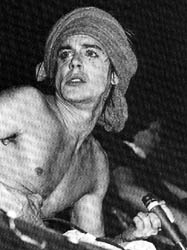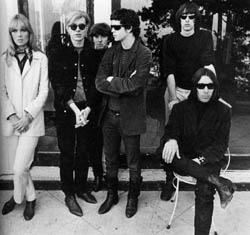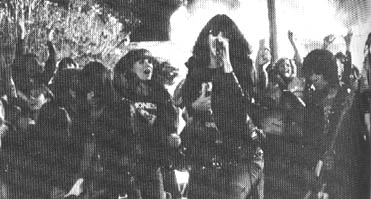A History of Punk
contributed by John Dizon
(Summer, 1998)
The punk culture can be traced back to the end of World War II, a new breed
of American rebel returning from Eurasia with the disillusioned angst
of the Rebels at Appomattox less than a century before them. Many of them drifted
to California, banding together in motorcycle clubs, roaming the countryside
on their Harleys and Indian bikes. Resembling pirate bands with their ragged
headbands, denim and leather jackets, they found inspiration in American jazz
and European-influenced coffeehouses. It was a new counterculture, a stark contrast
to the nationwide postwar scene which obsessively sought a return to `normalcy'
and American wholesomeness.
When Alan Freed brought rock and roll into
American culture in the early '50's, mind-controlled teens across the country
joined ranks with a vengeance. Elvis Presley was the
first to recognize the value of the `rebel' look, appearing onstage and in press
releases with the leather and denim look. He was followed by a swarm of imitators,
and Hollywood was quick to capitalize on the new trend. Marlon Brando and Lee
Marvin brought the biker look onto the silver screen in "The Wild One", followed
by James Dean in "Rebel Without A Cause". Finally the first R&R movie theme
made its debut as "Rock Around The Clock" opened "Blackboard Jungle".
Urban street gangs picked up on the biker look and the R&R culture as cities
across the country were flooded by punks in greased-back DA (duckass) haircuts,
T-shirts and denim, cruising around in souped-up cars listening to R&R blaring
on their radios. It changed the face of the nation until the Beatles
made the scene in the early '60's, deposing King Elvis in a historic coup d'etat.
The Rolling Stones arrived next in the British
invasion force, with Keith Richards providing the leather-and-denim rockers
with a new role model. The Stones proved a musical and cultural antithesis to
the cherubic Beatles, turning on a new generation of rockers to a new level
of anti-Establishment-Aryanism. The tragic debacle of Altamont
was perhaps the most painful growing experience of the decade as the role models
of the past, the biker gangs, ignited alongside the Stones as flame does with
kerosene. This destructiveness became associated with the rockers' philosophy,
though it was parodied by the rank-and-file with typical adolescent glee.
"West Side Story" became the ultimate stage satire on street gangdom. Dancing, prancing and singing punks gave new meaning to the Romeo and Juliet fable. Despite their violent nature, they were still the Bowery Boys and the East Side Kids of a previous generation. Crowded out by the growing Hippie
Revolution, they were still a force to be reckoned with though relegated to
the sidelines for a short time.
 Bands
such as Iggy and the Stooges and the MC5 kept the tradition of the two-chord
garage sound alive in the late '60's, epitomizing the street sound of the biker
culture. As rock musicians continued to experiment with hybrid sounds, the `hard
rock' bands maintained the R&R traditions, flavoring stanza/chorus/instrumental/stanza/chorus/fadeout
recipes with two or three-chord rhythms, short, concise lead riffs, and turbo-charged
backbeats that everyone could dance to. Yet even the most infamous of the hard
rock bands eventually sold out to music industry standards, stretching their
songs out to intolerable duration time, mixing in outlandish experimental (`psychedelic')
sound, bringing R&R to an all-time low in popularity.
Bands
such as Iggy and the Stooges and the MC5 kept the tradition of the two-chord
garage sound alive in the late '60's, epitomizing the street sound of the biker
culture. As rock musicians continued to experiment with hybrid sounds, the `hard
rock' bands maintained the R&R traditions, flavoring stanza/chorus/instrumental/stanza/chorus/fadeout
recipes with two or three-chord rhythms, short, concise lead riffs, and turbo-charged
backbeats that everyone could dance to. Yet even the most infamous of the hard
rock bands eventually sold out to music industry standards, stretching their
songs out to intolerable duration time, mixing in outlandish experimental (`psychedelic')
sound, bringing R&R to an all-time low in popularity.
 In
NYC, the Velvet Underground
made its appearance on the Greenwich Village scene with pop icon Andy Warhol
as its mentor. Musical prodigies Lou Reed and John Cale began mixing two-chord
garage rock with mindboggling electronic sound that rivaled the best of guitar
pioneer Jimi Hendrix. Their leather-and-denim look brought a resurgence of the
biker look to the streets of New York, providing an ominous glimpse of what
was to follow.
In
NYC, the Velvet Underground
made its appearance on the Greenwich Village scene with pop icon Andy Warhol
as its mentor. Musical prodigies Lou Reed and John Cale began mixing two-chord
garage rock with mindboggling electronic sound that rivaled the best of guitar
pioneer Jimi Hendrix. Their leather-and-denim look brought a resurgence of the
biker look to the streets of New York, providing an ominous glimpse of what
was to follow.
As the '70's commenced, the Alice
Cooper Group took advantage of the `glitter rock' craze featuring such androgynistic
stars as David Bowie, Elton
John and T-Rex. Their new `shock rock' featured a violent stage show which
satirized violence in the media, relying on the old `biker look' to reinforce
their image. Reverting to the old `garage' sound, their teen anthem, "School's
Out", became a classic hit.
Alice Cooper arrived just as Lou Reed had resurfaced in rock after leaving the Velvet Underground. Iggy Pop had just released "Raw Power", one of the greatest punk albums of all time. Together this denim-and-leather triumvirate became the standard-bearers for a new generation to follow. The New York Dolls began playing Soho, a glitter band that played three-chord rock like never before. This chain of events triggered a musical revolution that would be the last of its kind.
Rockers had grown disillusioned with the deterioration of rock brought on by
progressive bands who strained out the best of what R&R had to offer. Groups
such as Emerson, Lake and Palmer, the Moody
Blues, the Electric Light Orchestra, Yes,
Genesis, and many others had taken rock to a new plateau
of ennui. No longer was R&R being played in discotheques or at dance halls.
Instead it became background music for black light parties or concert halls
where rockers `tuned it, turned on and dropped out'. Twenty-minute dirges were
the new standard, and soon black music made a tremendous comeback in the dance-beat
sound of Disco Music. It kicked R&R out of the limelight,
infecting a dance-starved world with `disco fever'. Rock and roll had finally
seen its day. Or so it was thought.
Teens in NYC, fraught with the notion of becoming John travolta clones, returned to the denim-and-leather look of old. They began supporting underground bands who desperately sought the countercultural claims being laid by the Lou/Iggy/Dolls coalition.
A biker club on the Bowery called CBGB/OMFUG (Country and Blue Grass Bands/Other
Music For Unusual Gastronomics) began hosting these new groups, and soon the
Punk Revolution was born. Richard Hell and Tom Verlaine founded Television,
the first of the CBGB bands. Johnny Thunders left the Dolls to form the Heartbreakers,
another first-wave band. The Ramones, the epitome of the new style, followed
them into the new punk mecca.

The Ramones in the film "Rock 'n' Roll High School"
Max's Kansas City, a shrine for the avant-garde, began incorporating punk into their glitter-rock lineups. Soon more experimental bands such as the Talking Heads, Blondie and Devo found their way into the circuit as punk began expanding its horizons. By 1975, punk was being heralded as the Next Big Thing in American culture.
The CBGB bands opted for a fateful tour of England in 1976. The British rockers
had heard about the NYC scene and arrived in throngs to investigate. It became
a `Bizarro' event straight out of Superman comics, again taking punk
through another evolution that would change its history forever.
The British kids were stunned by the `new look'. Richard Hell often cut his own hair for lack of funds, giving him an odd and choppy hairstyle. The bands wore suits that they acquired at thrift shops for the same reason. They also favored ragged T-shirts, scruffy MC boots and cheap sunglasses. The Ramones' biker jackets, torn denim and sneakers completed a picture that was only inadvertantly presented. This new `punk look' raged through the UK, teens dressed in garish imitations of the CBGB look, taking the rest of Europe by storm.
The Sex Pistols were the most notorious
of the UK punk bands. Managed by Malcolm Mc Laren, a genius at manipulating
the press, they turned the notion of `image before virtuosity' into an art form.
The Pistols were banned throughout the UK, their sheer notoriety making it possible
for them to secure a record deal. They were followed by the Clash, the most
technically proficient of the UK punks, and the Police, the most commercially
successful.
Punk went through another evolution on the West Coast in the USA. The LA/SF bands began parodying the UK style, going a step further in dressing in garbage bags, psychedelic-colored punk paraphernalia, grotesque haircuts and futuristic S&M costumes. Fear, led by Lee Ving (who eventually appeared in "Flashdance" and "Streets of Fire" as a minor star), was among the best of these bands, along with Black Flag, the Nuns, the Germs, and Vom. Their proximity to Hollywood made it a vital link, and soon the Punk-Disco Wars raged throughout the end of the decade as the NYC/LA/London connection held fast against the Disco Music campaign for domination of the Music Industry.
It was the hardcore bands which led to the decline of punk in the early '80's, just as Disco began losing its grip on mainstream America. The Plasmatics in NYC, led by porn star Wendy O. Williams, reverted to Velvet Underground `white noise' without any musicianship behind it. The Dead Kennedys in LA began playing double-time music which no one could sing or dance to. It became a new fad which sounded the death knell for punk across America.
The Music Industry put an end to the Punk Wars by creating a bastardized form
of music called New Wave. Bands looked like punks
but sounded like synthesized disco. It gave the Industry a palatable form of
music which they could present on a new media, cable TV. R&R videos purveyed
the new fashion across America, commercializing the `punk look' while eliminating
its progenitors in one sweep.
It can be successfully argued that the Punk Revolution was the last in American pop culture. Disco gave way to Rap Music, which was a synthesis of its dance rhythms and the old `blues' street dialogue set to a rhythmic, chanting beat. Punk, however, remains imitated in `retro', `grunge', and other such rehashes, but never duplicated.
What made the Punk Culture so unique was its personalities and their eccentricities. Marlon Brando breathed new life into a fading biker counterculture. James Dean made it cool to steal the in-crowd's hottest chick and go hang out with the school outcast, a breed apart from the rest. Elvis Presley had the guts to risk it all by greasing his hair and shake his hips onstage before a TV audience. Keith Richards lived on the edge, seeming ready to breathe his last even on the Ed Sullivan Show.
Iggy Pop hung in there, a pariah among the new `hard rock' bands of the '60's until Lou Reed and his vampires scared the competition away. Alice Cooper took it to Billboard's Top Ten, stunning the nation with his spiders and snakes as R&R once again became in `vogue'.
Yet it was the cartoon violence that they represented that made it so American. The Fonz on "Happy Days" became the most lovable punk in history. The Ramones never once looked like they could punch anybody out. Sylvester Stallone in the "Lords of Flatbush" was the prototypical "West Side Story" neanderthal with a brain of tin and a heart of gold. Despite their menacing biker look, they remained a bunch of pimply adolescents, chewing gum and drinking beer because they were too poor to buy drugs.
Yet punk music remains curiously immortal. Play Frank Sinatra and you will receive the accolades of senior citizens across the dance hall. Play Elvis Presley and your older aunts and uncles will `twist again'. Spin some Beatles and Stones and your Baby Boomer friends will smile and remember. Kick out some Disco jams and your parents will get up and dance.
Try some Sex Pistols, Ramones, Black Flag, Dead Boys or Velvet Underground
music in any barroom in the country. Heads will turn, conversations will stop,
and people will wonder where the hell that loud and nasty new stuff came from.
It remains as boisterous and challenging as it was when it first came out. People
will look back at Led Zeppelin,
Iron Butterfly, Blue Cheer and Steppenwolf with nostalgic gazes. It is doubtful
that punk will ever be looked back on, but rather reopened now and again as
the sounds of Pandora's Box.
Just as the city of Atlantis, punk has disappeared beneath the waves of history. Yet its story remains forever.
 Bands
such as Iggy and the Stooges and the MC5 kept the tradition of the two-chord
garage sound alive in the late '60's, epitomizing the street sound of the biker
culture. As rock musicians continued to experiment with hybrid sounds, the `hard
rock' bands maintained the R&R traditions, flavoring stanza/chorus/instrumental/stanza/chorus/fadeout
recipes with two or three-chord rhythms, short, concise lead riffs, and turbo-charged
backbeats that everyone could dance to. Yet even the most infamous of the hard
rock bands eventually sold out to music industry standards, stretching their
songs out to intolerable duration time, mixing in outlandish experimental (`psychedelic')
sound, bringing R&R to an all-time low in popularity.
Bands
such as Iggy and the Stooges and the MC5 kept the tradition of the two-chord
garage sound alive in the late '60's, epitomizing the street sound of the biker
culture. As rock musicians continued to experiment with hybrid sounds, the `hard
rock' bands maintained the R&R traditions, flavoring stanza/chorus/instrumental/stanza/chorus/fadeout
recipes with two or three-chord rhythms, short, concise lead riffs, and turbo-charged
backbeats that everyone could dance to. Yet even the most infamous of the hard
rock bands eventually sold out to music industry standards, stretching their
songs out to intolerable duration time, mixing in outlandish experimental (`psychedelic')
sound, bringing R&R to an all-time low in popularity.  In
NYC, the
In
NYC, the 